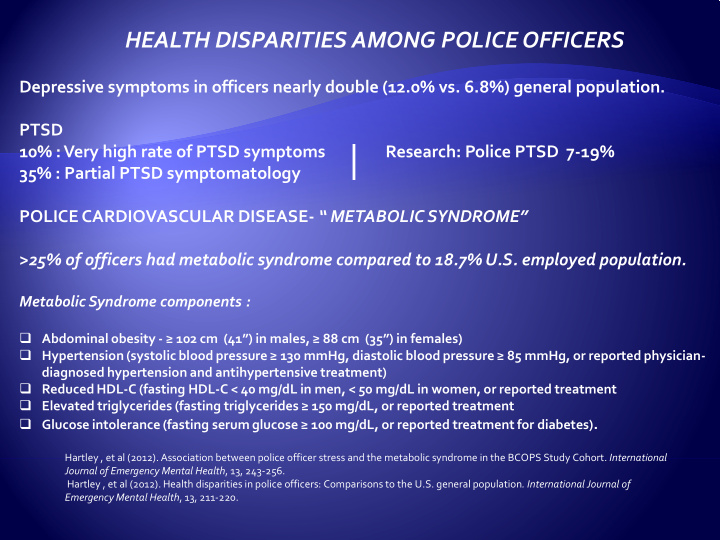



HEALTH DISPARITIES AMONG POLICE OFFICERS Depressive symptoms in officers nearly double (12.0% vs. 6.8%) general population. PTSD 10% : Very high rate of PTSD symptoms Research: Police PTSD 7-19% 35% : Partial PTSD symptomatology POLICE CARDIOVASCULAR DISEASE- “ METABOLIC SYNDROME” >25% of officers had metabolic syndrome compared to 18.7% U.S. employed population. Metabolic Syndrome components : Abdominal obesity - ≥ 102 cm (41”) in males, ≥ 88 cm (35”) in females) Hypertension (systolic blood pressure ≥ 130 mmHg, diastolic blood pressure ≥ 85 mmHg, or reported physician - diagnosed hypertension and antihypertensive treatment) Reduced HDL-C (fasting HDL-C < 40 mg/dL in men, < 50 mg/dL in women, or reported treatment Elevated triglycerides (fasting triglycerides ≥ 150 mg/ dL, or reported treatment Glucose intolerance (fasting serum glucose ≥ 100 mg/ dL, or reported treatment for diabetes) . Hartley , et al (2012). Association between police officer stress and the metabolic syndrome in the BCOPS Study Cohort. International Journal of Emergency Mental Health , 13, 243-256. Hartley , et al (2012). Health disparities in police officers: Comparisons to the U.S. general population . International Journal of Emergency Mental Health , 13, 211-220.
SHIFT WORK , SLEEP, AND METABOLIC SYNDROME Officers who worked nights and had <6 hrs. sleep had a 4-fold greater number of metabolic syndrome components than officers working the day shift. Day Afternoon Night Police 4 x more likely to sleep 3.0 p=0.213 p=0.013 p=0.863 <6 hrs. than population (33% No. of MS Components 2.5 vs. 8%). 2.0 Stress- High stress led to poor 1.5 Sleep quality in both men and 1.0 women officers. 0.5 0.0 ≥ 6 hrs of Overall < 6 hrs of Sleep Sleep Violanti, et al (2009). Atypical Work Hours and Metabolic Syndrome Among Police Officers. Archives of Environmental and Occupational Health , 64, 194-201. Charles et al (2012). Associations of perceived stress with sleep duration and sleep quality: The BCOPS Study. International Journal of Emergency Mental Health , 13, 229-242
20 18 Night shift workers had a 16 Afternoon Cortisol (nmol/L) significantly diminished response 14 pattern compared to afternoon and Day 12 day shift workers. 10 Night 8 6 4 Wirth et al (2011). Shift work duration and patterns of salivary cortisol secretion among police officers. 2 Chronobiology International, 28, 446-457. 0 0 10 20 30 40 50 Time from awakening (minutes)
12.0 11.2 10.0 The incidence of first injury Incidence per 100,000 was over 2-fold higher in 8.0 midnight shift workers person-hours compared to day shift 6.0 workers: 11.2 vs. 5.2 injuries 6.3 per 100,000 person-hours. 5.2 4.0 2.0 0.0 Day Afternoon Midnight Violanti, et al (2012). Shift work and the incidence of injury among police officers. American Journal of Industrial Medicine, 55, 217-227
POLICE SUICIDE Trends in Police Suicide: CDC National Ocupational Mortality Surveilance1984-1998 OUR MOST RECENT STUDY Approx. 18/100,000 120 • 2008: 141 POLICE SUICIDES 100 • 2009: 143 POLICE SUICIDES 80 • 2010 147 POLICE SUICIDES 60 • 2012- 96 suicides (as of 9-1) 40 • Most- white male (95%) 20 • 35-44 age group (40%) • Patrol level (90%) 0 1984 1985 1986 1987 1988 1989 1990 1991 1992 1993 1994 1995 1996 1997 1998 • Used firearm (94%) Police Suicides Log. (Police Suicides) O’Hara, A.F. & Violanti, J.M.. Police suicide: A web surveillance of national data. International Journal of Emergency Violanti, J.M. (2010). Police suicide: A national comparison with fire-fighter and military Mental Health, 11, 17-24. personnel . International Journal of Police Strategies & Management , 33, 270-286. DOI 10.1108/13639511011044885.
Recommend
More recommend